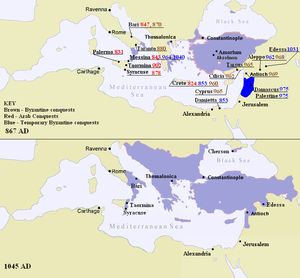Byzantine–Arab wars (780–1180)
| Byzantine–Arab Wars (780–1180) | |||||||||
|---|---|---|---|---|---|---|---|---|---|
| Part of the Byzantine-Arab Wars | |||||||||
|
|||||||||
| Belligerents | |||||||||
|
Byzantine Empire Holy Roman Empire Italian city-states Crusader states |
Fatimid Caliphate Abbasid Caliphate Uqaylids Hamdanids Emirate of Sicily Emirate of Crete |
||||||||
| Commanders and leaders | |||||||||
|
Byzantine Emperors Strategoi of the Themata Drungaries of the Fleets |
Fatimid Caliphate rulers Abbasid Caliphate |
||||||||
| Strength | |||||||||
| Total Strength 400,000 in 773 Total Strength 250,000 in 1025 Total Strength 50,000 + militia in 1140 |
Abbasid Strength 100,000 in 781 Abbasid Strength 135,000 in 806 |
||||||||
Between 780–1180, the Byzantine Empire and the Abbasid & Fatimid caliphates in the regions of Iraq, Palestine, Syria, Anatolia and Southern Italy fought a series of wars for supremacy in the Eastern Mediterranean. After a period of indecisive and slow border warfare, a string of almost unbroken Byzantine victories in the late 10th and early 11th centuries allowed three Byzantine Emperors, namely Nikephoros II Phocas, John I Tzimiskes and finally Basil II to recapture territory lost to the Muslim conquests in the 7th century Byzantine-Arab Wars under the failing Heraclian Dynasty.
Consequently, large parts of Syria, including its capital city of Damascus, were taken by the Byzantines, even if only for a few years, with a new theme of Syria integrated into the expanding empire. In addition to the natural gains of land, and wealth and manpower received from these victories, the Byzantines also inflicted a psychological defeat on their opponents by recapturing territory deemed holy and important to Christendom, in particular the city of Antioch—allowing Byzantium to hold two of Christendoms' five most important Patriarchs, those making up the Pentarchy.
Nonetheless, the Arabs remained a fierce opponent to the Byzantines and a temporary Fatimid recovery after c. 970 had the potential to reverse many of the earlier victories. And while Byzantium took large parts of Palestine, Jerusalem was left untouched and the ideological victory from the campaign was not as great as it could have been had Byzantium recaptured this fourth Patriarchal seat of Christendom. Byzantine attempts to stem the slow but successful Arab conquest of Sicily ended in a dismal failure. Syria would cease to exist as a Byzantine province when the Turks took the city of Antioch in c. 1084. The Crusaders took the city back for Christendom in 1097 but a Byzantine protectorate was established over the Crusader Kingdoms in Jerusalem and Antioch under Manuel I Komnenos. The death of Manuel Komnenos in 1180 terminated military campaigns far from Constantinople and after the Fourth Crusade both the Byzantines and the Arabs were engaged in other conflicts until they were conquered by the Ottoman Turks in the 15th and 16th centuries, respectively.
...
Wikipedia

